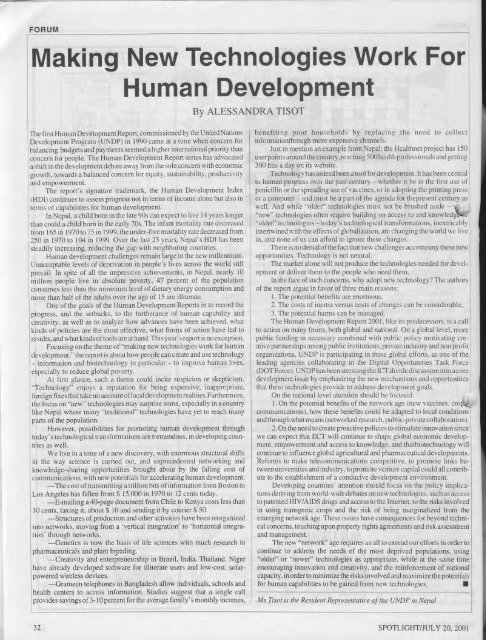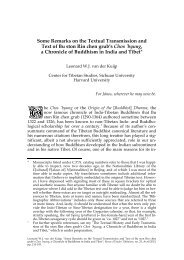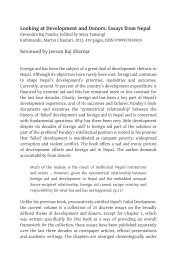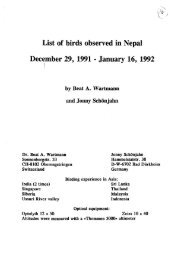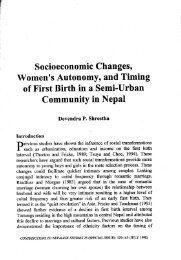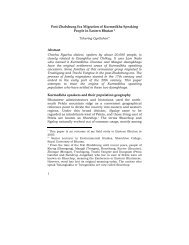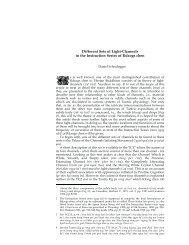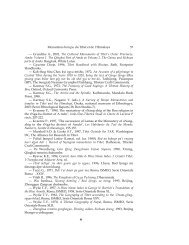• RNA Gheraoes Maoists • Vajpayee-Musharraf ... - Digital Himalaya
• RNA Gheraoes Maoists • Vajpayee-Musharraf ... - Digital Himalaya
• RNA Gheraoes Maoists • Vajpayee-Musharraf ... - Digital Himalaya
Create successful ePaper yourself
Turn your PDF publications into a flip-book with our unique Google optimized e-Paper software.
FORUM<br />
Making New Technologies Work For<br />
Human Development<br />
By ALESSANDRA TISOT<br />
The first Human Development Report. commissioned by the United Nations<br />
Development Program (UNDP) in 1990 came at a time when concern for<br />
balancing budgets and payments seemed a higher international priority than<br />
conce rn for people. The Human Development Report series has advocated<br />
a shift in the development debate away from Ihesole concern with economic<br />
growth, towards a balanced concern for equiry. suslainability. productivity<br />
and empowerment.<br />
The repon's signature trademark. the Human Development Index<br />
(HDI) continues to assess progress not in lemlS of income alone but also in<br />
tcnns of capabilities for human development.<br />
In Nepal. achild born in the late 90s can expect to live 14 years longer<br />
than cou ld a child born in the early 70s. The infant mOI1ality rale decreased<br />
from 165 in 1970 to 75 in 1999. the under-five mOI1alily rate decreased from<br />
250 in 1970 la 104 in 1999. Over the last 25 years. Nepal's I-IDI has been<br />
steadily increasing. reducing the gap with neighboring countries.<br />
Hum an development challenges remain large in the new millennium.<br />
Unacceptable levels of deprivation in people's lives across the world still<br />
prevail. In spite of all the impressive achievements. in Nepal, nearly ID<br />
million people li ve in absolu te poverty. 47 percent of the population<br />
consumes less than the minimum level of dielary energy consumption and<br />
more than half of the adults over the age of 15 are illiterate.<br />
Onc of the goals of the Hum an Development Repolls in 10 record the<br />
progress. and the setbacks. to the furtherance of human capability and<br />
creativity. as well as to analyze how advances have been achieved. what<br />
kinds of policies are the most effective. what fonns of action have led to<br />
results. and what kinds of 100 Is are at hand. This year's repon is no exception.<br />
Focusing on the theme of "making new technologies work for human<br />
development." the repon is about how people can create and use technology<br />
- infonnation and biotechnology in particular - to improve human lives,<br />
especial1y to reduce global poveny.<br />
At rlfSt glance. such a theme could incite suspicion or skepticism.<br />
'"Techno logy" enjoys a reputation for being expensive. inappropriate.<br />
foreign fixe s that take no account ofloeal development realities.Furthennore.<br />
the focus on "new" technologies may surprise some. especially in a country<br />
like Nepal where many "traditional" technologies have yet to reach many<br />
parts of the population.<br />
However, possibilities for promoting human development through<br />
today's technologicaltransfonnations are tremendous. in developing cou n<br />
tries as well.<br />
We li ve in a lime of a new di scovery. with enonnous structural shi fts<br />
in the way science is carried out. and unprecedented networking and<br />
knowledge-sharing opportunities brought about by the falling cost of<br />
communications. with new potentials for accelerating human development.<br />
-The cost of transmitting a trillion bits ofinfonnation from Boston to<br />
Los Angeles has fallen from $ 15.000 in 1970 to 12 cents today.<br />
-E-mailing a 40-page document from Chile to Kenya costs less than<br />
10 cents. faxing it. about $ 10 and sending it by cou rier $ 50.<br />
-Structures of production and other activities have been reorganized<br />
into networks. moving from a 'vertical integration' 10 'horizontal integration'<br />
through nctworks.<br />
--Genetics is now the basis of life sciences with much research in<br />
pharmaceuticals and plant breeding.<br />
-Creativity and enterrreneurship in Brazil. India, Thailand. Niger<br />
have already deveJoped software for illiterme users and low-cost. solarpowered<br />
wireless devices.<br />
-Grameen telephones in Bangladesh allow individuals, schools and<br />
health centers to access information. Studies suggest that a single call<br />
provides savings 01'3- 1 0 percent for the average famil y's monthly incomes,<br />
benefiting poor households by replacing the need 10 collect<br />
infonnationthrough more expensive channels.<br />
Just to mention an example from Nepal: the Healthnet project has 150<br />
user poinls around the counl ry. reaching 500 health professionals and getting<br />
300 hits a day on its website.<br />
Technology has indeed been a tool for development. It has been central<br />
to human progress over the past century - whether it be in the Ersl llse of<br />
penicillin or the spreading use of vaccines. or in adopt ing the printing press<br />
or a computer - and must be a part of Ihe agenda for thepresem cemul), as<br />
well. And while "older" tech nologies mllst not be brushed aside - ' ~<br />
"new" technologies often require building on access to and knowledg<br />
"older" technologies - today's technological transfonnalions. inextricably<br />
intertwined with the effects of globalization. are changing the world we live I<br />
in. and none of us can afford to ignore these changes.<br />
There is nodenial oflhe fact that new challenges accompany these new<br />
opportunities. Technology is not neutral.<br />
The market alone will not produce the technologies needed for development<br />
or deliver them to the people who need them.<br />
In the face of such concerns. why adopt new teChnology? The a.u thors<br />
of the report argue in favor of three main reasons:<br />
I. The potential benefits are enonnous.<br />
2. The costs of inertia ve rsus costs of changes can be conSIderable.<br />
3. The potential hanns can be managed.<br />
The Human Development Report 200 I. like its predecessors. is a call<br />
to action on many fronts. both global and national. On a global level. more<br />
public funding in necessary combined with public policy moti vating creative<br />
partnerships among public institutions. private industry and non profit<br />
organizations. UNDP is participating in these global efforts. as one of the t<br />
leading agencies collaborating in the <strong>Digital</strong> Opportunities Task Force I<br />
(DOT Force). UNDP~las been stressing the ICT divide di scussion into a core<br />
development issue by emphasizing the new me chani s m~ and opportunities<br />
thal these technologies provide 10 address developme nt goals.<br />
On the national level attention should be focused:<br />
I. On the potential benefits oflhe network age (new vaccines. cro<br />
communications). how these benefits could be adapted to local conditions<br />
and through what means (networked research. public-private collaboration).<br />
2. On the need 10 create proactive policies to stimulate innovation since<br />
we can expect that ECT will continue to shape global economic development.<br />
empowerment and access to knowledge. and thatbiotechnology will<br />
continue to influence global agricultural and phannaceutical developments.<br />
Refonns to make telecommunications competitive. to promote links between<br />
universities and industry. to promote venture capital could all co ntribute<br />
to the establishment of a conducive development environment.<br />
Developing countries' anention should focus on the policy implications<br />
deriving from world-wide debates on new technologies. such as access<br />
to patented H IV IA lDS drugs and access to the InLemct.lo [he risks involved<br />
in using transgenic crops and the ri sk of bei ng marginalized from the<br />
emerging network age. These issues have consequences for beyond technical<br />
concerns. touching upon property rights agreements and risk assessment<br />
and management.<br />
The new "network" age requires us all to extend oureffoI1S in order 10<br />
continue to add ress the needs of the most deprived populations, using<br />
"older" or "newer" technologies as appropriate. while at the same time<br />
encouraging innovation and creativity. and the reinforcement of national<br />
capac ilY. in order to minimize the risks involved and maximize the potentials<br />
for human capabilities to be gained from new technologies. <strong>•</strong><br />
Ms Tisot is the Residell! Representative oIthe UNDP ill Nepal<br />
32<br />
SPOTLlGHTlJUL Y 20. 2001


